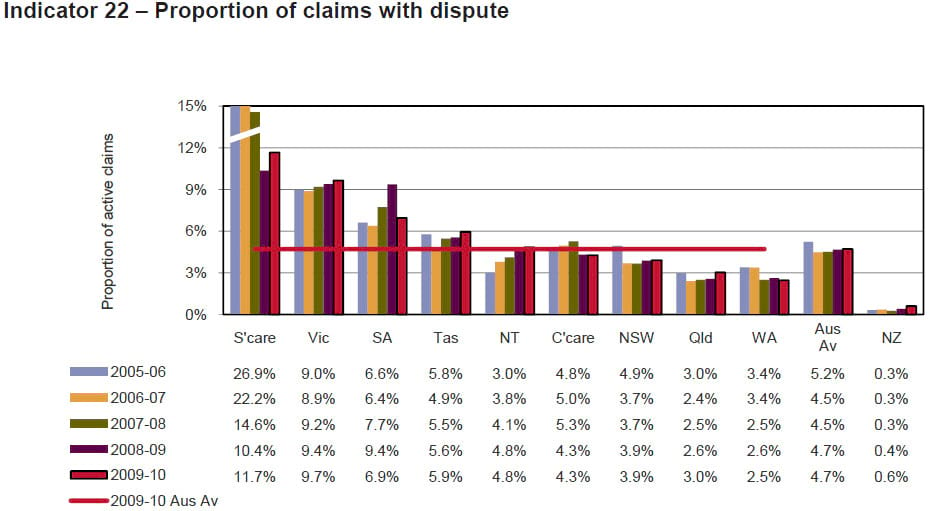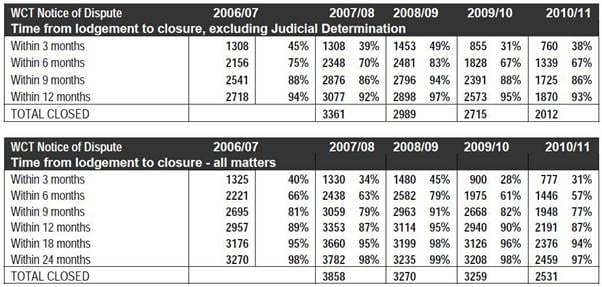Consider the alternative: Part 9 - South Australia

In Part 9 of our ongoing series on the use of Alternative Dispute Resolution in workers’ compensation disputes we look out South Australia. New to the series? Take a look at previous articles:
- Part 1 – An Introduction to Alternative Dispute Resolution
- Part 2 – What makes a good workers' comp system with Nerida Wallace, Principal of Transformation Management
- Part 3 – Victoria
- Part 4 – New South Wales with Sian Leathem, Registrar of the NSW Workers Compensation Commission
- Part 5 - Queensland with Elizabeth Woods, CEO of Q-COMP
- Part 6 - Western Australia with WorkCover WA
- Part 7 - Tasmania with Stephen Carey, Commissioner of the Tasmanian Workers Rehabilitation and Compensation Tribunal
- Part 8 - Northern Territory with NT WorkSafe
WORKERS’ COMPENSATION IN SOUTH AUSTRALIA BY THE NUMBERS
Disputation Rate

Graph from the 2011 Comparative Performance Monitoring Report (p. 38)
South Australia’s Disputation rate of 6.9% in 2010-11 was the second highest of any State or Territory (Victoria), but represented a significant reduction of 2.5% from a year ago.
According to the 2011 Comparative Performance Monitoring Report “The disputation rate for South Australian increased in 2008-09 mainly due to the major legislative changes that commenced from 1 July 2008. The rate for 2009-10 reduced significantly and returned to levels similar to that of 2005-06.”
Resolution Rates

Charts from the 2010-11 South Australian Industrial Relations Tribunal Annual Report (PDF - p. 40)
South Australian numbers were not featured in the Comparative Performance Monitoring Report, but according to the South Australian Industrial Relations Tribunal’s Annual Report “the WCT continues to be able to assist parties in reaching a conciliated outcome in the vast majority of cases and in a relatively timely way.”
With former Premier Mike Rann’s 2008 overhaul of the workers’ compensation system, resolution rates have been on a rollercoaster ride over the last 4 years, but have returned, to near 2007-08 levels.
Durable RTW
.jpg)
Graph from the 2011 Comparative Performance Monitoring Report (p. 36)
At 71% for the 2010-11 period, South Australia’s Durable RTW rate was the lowest of any Australian State or Territory, the second lowest of any reported jurisdiction (behind only Seacare), and 3% below the national average. It should be noted that the difference was 13% just five years ago, a gap that has closed considerably.
THE SOUTH AUSTRALIAN SYSTEM
The South Australian system requires the initial decision-maker to review their decision before an attempt to conciliate takes place. If the matter remains unresolved after these two steps, it may be referred to the Courts.
Notice of Dispute
If a claim for compensation has been rejected and the worker is not satisfied by their case manager’s explanation, they are entitled to lodge a dispute with the South Australian Workers Compensation Tribunal by filing a Notice of dispute. This must be done within one month of the claim decision (although workers can apply for an extension of an additional month).
Review of Decision
After receiving the Notice of dispute, the Tribunal then directs the SA claims agent (Employers Mutual) or the self-insured employer (employers that fund and manage their own workers rehabilitation and compensation claims) to review their own decision.
If the decision is not changed, or it is changed and the worker is not happy with it, they may lodge a Notice of dissatisfaction with the Tribunal. At this stage a conciliation officer will be appointed.
Conciliation
The appointed conciliation officer will convene a dispute management conference where the parties will come together and attempt to resolve the matter informally.
If an agreement is not able to be reached, a compulsory conciliation conference will be arranged (must take place within 21 days of the matter being referred), and the parties will sit down and attempt to come to an agreement with the help of a neutral third party.
According to Schedule 2 of the Workers Compensation Tribunal Rules 2009, Conciliation in the WCT seeks to:
- Identify and isolate the issues in dispute between the parties.
- Develop options for the resolution of these issues.
- Enable the parties, if appropriate, to explore options beyond the issues in dispute between them to bring about a satisfactory resolution of their differences.
- Enable the parties to have their say and to share with others involved in their dispute, their feelings and concerns in a confidential non-threatening environment without prejudice to their rights and entitlements.
- Assist the parties in understanding the perspective of the other parties to the dispute
- Promote constructive, satisfying and enduring solutions to their dispute.
Without imposing a solution, the conciliator will guide discussions and try to get the parties to agree on commonly disputed aspects of claims such as:
- The nature or severity of the injury;The cause of the injury (whether it can be medically proven that the injury was sustained on the job);
- What earnings were lost as a result of the injury (i.e. predicting likely earnings for casual employees); and
- The likely period of inability to work after surgery.
Court Hearing
If an agreement cannot be reached in conciliation, or a party is unhappy with the decision it produces, a party has 14 days to request a judicial determination.
These disputes are heard by one judge or three if the dispute is complex.
Medical Panels
Medical Panels came into effect in South Australia on 1 April 2009. The Panels are comprised of a number of medical experts whose job is to assess injuries, and to provide an (until recently) final and binding opinion within 60 days of the referral.
WorkCoverSA’s info sheet ‘Help when you’re not satisfied. A guide to workers compensation disputes’ (PDF) provides additional detail about the South Australian system.
WORKERS’ COMPENSATION DEVELOPMENTS IN SOUTH AUSTRALIA
Supreme Court Challenge to Medical Panels in 2011
South Australia’s workers’ compensation system found itself in the news this year with a challenge to the Constitutionality of Medicals and the validity of the decisions they make. For an in-depth look at the issue, see Sean Gleeson’s feature article ‘Big trouble in little Adelaide’.
In June of this year, the Supreme Court of South Australia handed down its decision in Yaghoubi and Campbell. In short, the case asked three questions, and the court delivered three answers:
Q. Are Medical Panels Constitutional?
A. Yes
Q. Can a referral to a Medical Panel at any stage of a worker’s claim before or during a Tribunal proceeding?
A. Yes
Q. Is the opinion of a Medical Panel final and binding on all parties to a dispute, including the Tribunal
A. No
The effect of this decision is that the injured worker is compelled to attend Medical Panels when requested, but the Tribunal will now dictate the significance of that hearing. While the Tribunal may consider the opinion of a Medical Panel, it no longer has to accept it.
The precise effect that this will have is still unclear. One factor behind the implementation of the $10 million Medical Panel system was to reduce the amount of work for the Tribunal, and the system’s overall efficiency rested in part with the Panel’s ability to deliver final decisions on important questions. On the other hand, others would say that a lack of a right to legal counsel or a right of appeal is to high of a price to pay for WorkCover’s scheme efficiency.
SUMMING UP THE USE OF ADR IN WORKERS’ COMPENSATION DISPUTES
In his Address to Both Sides of the Fence Seminar on 23 October 2009, Judge Brian Gilchrist summed up the tensions and difficulties associated with developing a workers’ compensation system, including the use of ADR.
“the search for the ideal workers compensation scheme is elusive.
Where do you strike the balance between creating a scheme that delivers proper compensation to injured workers and adequately recompenses them for their losses and which is at the same time affordable and enables businesses in this State to compete nationally?
How do you devise a mechanism that allows those for whom rehabilitation has not been effective to leave the scheme with some dignity that does not promote the lump sum mentality that has been seen as a blight on workers compensation in this State for the best part of forty years?
What dispute resolution scheme can you devise that on the one hand recognizes that the expeditious resolution of workers compensation disputes is critical because delay will frustrate effective rehabilitation and may cause severe financial hardship for workers and their families and yet on the other recognizes that the outcome of a workers compensation dispute may have profound consequences and as such should be determined fairly and according to law?”
If we could sum up this series of articles in one word, it would have to be ‘reform’. As a testament to Judge Gilchrist’s position, most of the jurisdictions not implementing reforms were either planning to implement them or conducting reviews of the existing system.
In terms of the place of ADR in workers’ compensation disputes, most systems are at least attempting to strike the right balance in making sure parties have every opportunity to reach an agreement without recourse to the legal system.
While ADR is just one part of incredibly complex workers’ compensation system’s all jurisdictions agree that it is an important part, and one that continues to improve outcomes for injured workers and their employers.

